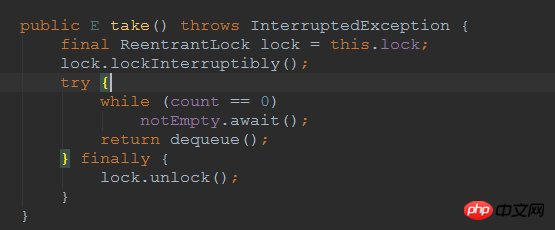Warum verwendet die take()-Methode eine while-Schleife anstelle von if, wenn sie beurteilt, ob die Anzahl der Elemente in der Warteschlange 0 ist?

我认为,如果notEmpty.await()方法既然苏醒返回了 ,那么此线程肯定拿到了lock。 Ich weiß nicht, was der Autor mit „while“ meint?
“notEmpty.await()方法既然苏醒返回了 ,那么此线程肯定拿到了 lock” 这句话是正确的。
假设你写的代码是:
可以明确的一点就是我们需要保证在
return dequeue()之前需要满足的一个条件是count != 0。我们假设 线程A 此时拿到了 lock,那么 线程A 的notEmpty.await()此时便会停止阻塞,准备向下执行return dequeue()。但是假设在竞争激烈的条件下,线程A 拿到 lock 之后,准备执行下一条 JVM 指令的时候,线程B 此时抢占了 lock,然后继续向下执行return dequeue(),刚好使得 count 变为了 0;而此时因为写的只是if(count == 0),那么线程 A 在拿到 lock 之后,还是会继续向下执行return dequeue(),从而导致了错误。关于为什么
wait()、await()这样当条件不满足时就阻塞的方法一定要在 while 循环中使用,可以参考《Effective Java》第二版第 69 条(244 页)。所以在你这段代码里当前队列为空时(count==0),调用了
notEmpty.await(),这段代码对锁是有影响的,实际上底层上已经释放了锁,只是这个方法保证了被唤醒时一定又能够拿回锁(当有元素放入队列会调用notEmpty.signal()进行唤醒),那为什么需要使用while呢?因为insert后lock.unlock,未必notEmpty.await()立即被唤醒,可能之前插入一个线程运行remove方法